There are well over 200 types of owls in the world that live on all continents except Antarctica.
With almost half of the human population having associative thinking, it was indivertible that an abundance of legends as tall as the Burj Khalifa would develop around these birds.
As your curious mind might know, owls have played a central role in the human story.
Greeks revered owls as symbols of victory and knowledge, which is reason enough to study a couple of these different types of owls while we still can, isn’t it?
A little understanding can help everyone realize that owls are more than natural pest control but magnificent types of birds.
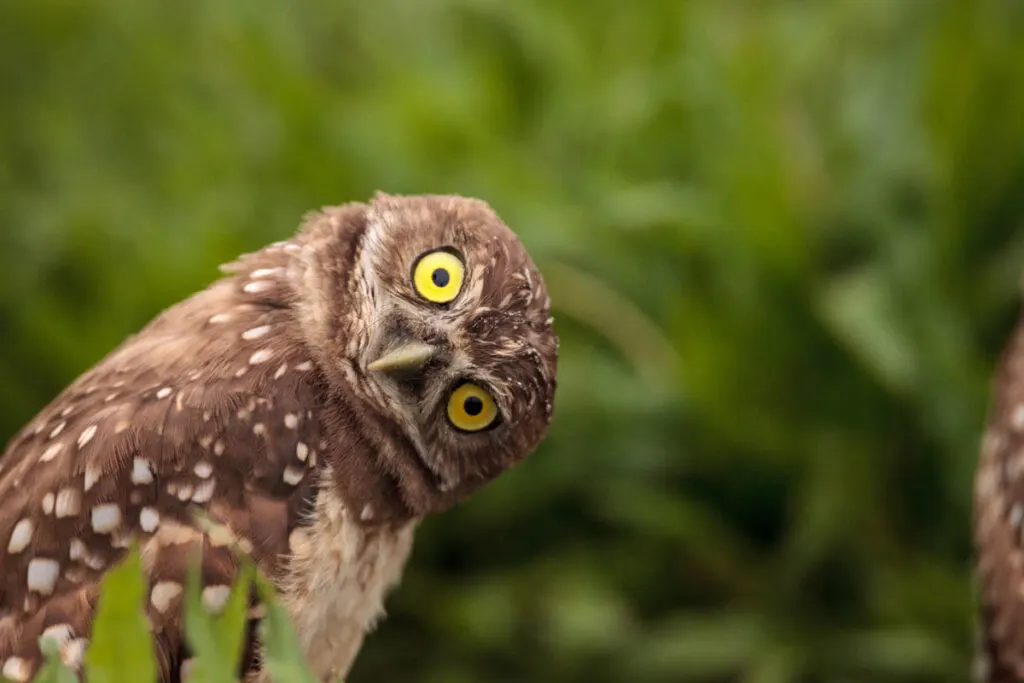
What Is An Owl?
Regardless of the types of owls in question, most owls have a distinct and similar physical appearance.
The round, facial disk face helps them focus sounds toward their large, feathered ears.
Most owls have asymmetrically positioned ears that help triangulate the prey’s position from the littlest sounds.
The mostly brown-spotted and white plumage is soft to the touch and densely packed.
As with most of the owl’s characteristics, the fluffy feathers help owls make virtually no noise when flying through the night sky.
The stealthy feathers pair incredibly well with the owl’s large, bulbous forward-facing eyes to create a deadly predator.
The yellow/orange eyes practically don’t move, which forces the owl to move its entire broad head more than 180 degrees on either side to survey its surrounding.
Although owls don’t neatly fall into the diurnal or nocturnal group, most owls use the binocular vision and low-light capability of their eyes to swoop down from tree perches in the dead of night and catch their prey using their sharp talons.
Owls have four curved and sharp talons that they use like surgical blades to sever the prey’s spine during a hunt.
One of the toes even acts like an opposable thumb to secure its vice grip on its prey. The owl’s legs are medium-sized for a bird but possess a surprising amount of power.
Owls are scientifically classified as raptors, birds of prey, and are referred to as Strigiformes. This Strigiformes order is split into two main types of owls: Tytonidae and Strigidae.
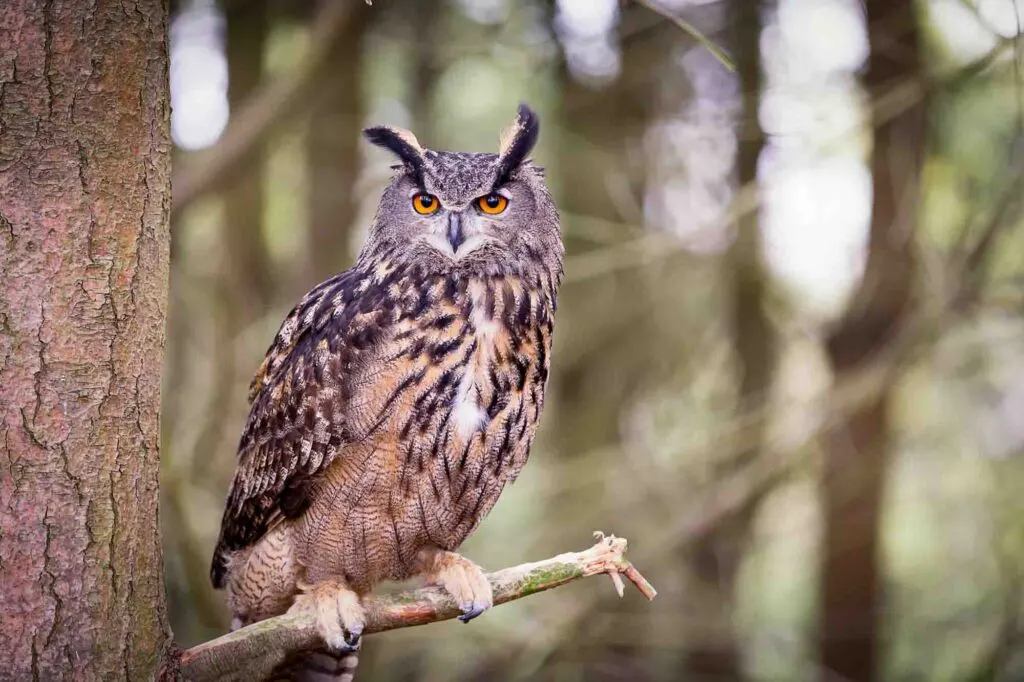
The Two Owl Types
Many people have a general picture of what an owl looks like, but what we might not is that the many types of owls are categorized into two the Tytonidae and Strigidae families.
The majority of owl types often depicted in media fall into the Strigidae (true owl) family.
This family has around 190 species of owls from the total number that we currently know of. The remaining owl types are under the Tytonidae (barn owl) family.
One way to classify the types of owls into the two families is through their physical appearance, feeding behavior, lifespan, and calls.
An owl’s look and call can tell you more about which group to put the types of owls you’re looking at into.
Most true owls spot the rounded facial disk that gives an owl its distinct look. Besides functioning as tools to precision hunting tools, true owls have ear tufts that can help camouflage these owls as a tree branch when perched on a tree.
The soft feathers over the ears can still allow sound to pass through without any issues.
On the other hand, barn owls have a more heart-shaped head which gives them the pleasure of being called “sweetheart owls.”
The most distinguishable feature of the barn owl is its smaller and darker eyes.
Unlike true owls, the barn owl’s small, hooked beak is placed lower on the bird’s face. Barn owls have ear holes instead of ear tufts.
The ear holes are usually behind the eyes but still clearly receive the sound focused by the facial disk trait.
19 Magnificent Types of Owls to Spot in the Wild
Here are 19 different types of owls that you can spot in the wild. How many of these impressive birds have you seen in real life? Let us know in the comments! We’d love to hear from you!
1. Great Horned Owl
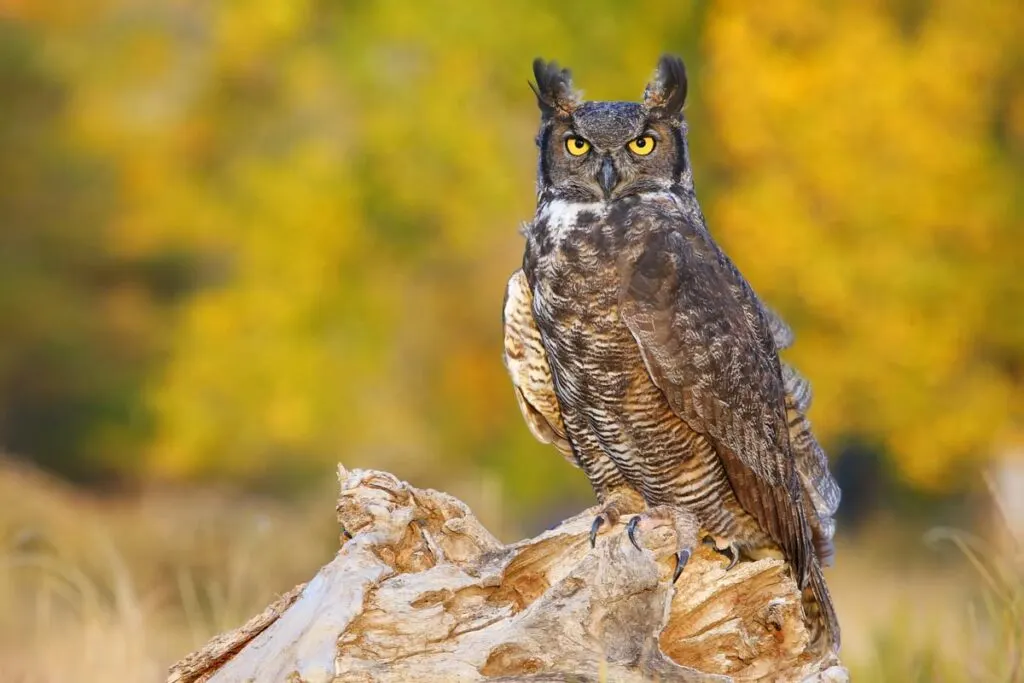
Bubo virgianus are a lot of owl at 2 to 5.5 pounds. Still, they don’t throw their weight around the whole place as they’re primarily found in North America and some parts of South America, where they are apex predators.
Great horned owls are solitary animals that have evolved to be highly adaptable.
They can survive in cities, suburbia, parks, forests, swamps, deserts, the edge of the tundra, and a couple of other environments.
Wherever you may find these majestic creatures, you’ll see that they keep a steady diet of small rodents, geese, and skunks, something impressive as they sometimes swallow their prey whole.
2. Cactus Ferruginous Pygmy-Owl
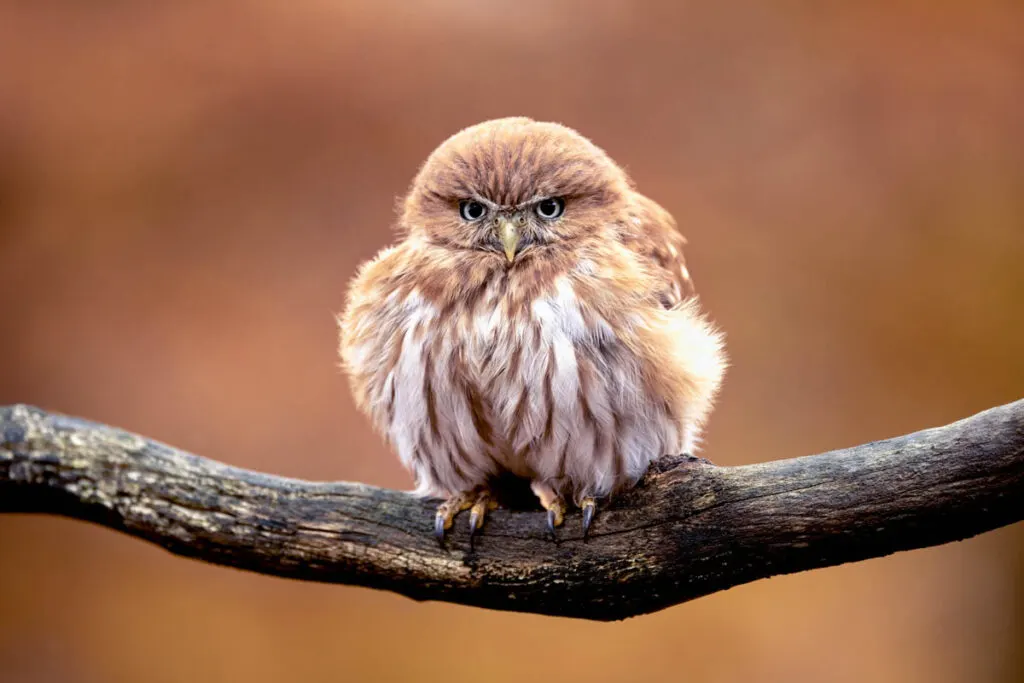
Cactus ferruginous pygmy-owls or Glaucidium brasilianum cactorum, if you speak science tongue, have been listed as an endangered owl species since 1997.
The most pressing threat to the population of these owls is the destruction and modification of their habitats.
Ferruginous pygmy prefers a range of deserts and xeric scrub, subtropical, and woodland environments at elevations of under 4,000 feet.
Dense wooded thickets or woodlands are the main similarities in all their habit choices; we have fewer and fewer of those yearly, so they are becoming rare animals, unfortunately.
Pygmy owls can be found in the country’s northernmost regions, as far as New River toward the northern side of Phoenix.
They also have a sizeable population inhabiting the lowlands of central and southern Arizona, like cottonwood forests and woodlands.
To sustain their average weight of 0.141 pounds for males and 0.163 pounds for females, pygmy owls will prey on species of birds, insects, amphibians, small mammals, and lizards.
Curiously, the pygmy owl also has no ear tufts and boasts one of the longest owl tails.
Did you know? Of all the collective nouns for animals, the collective nouns for birds are the most curious ones. A group of owls is called a parliament of owls!
3. Short-Eared Owl
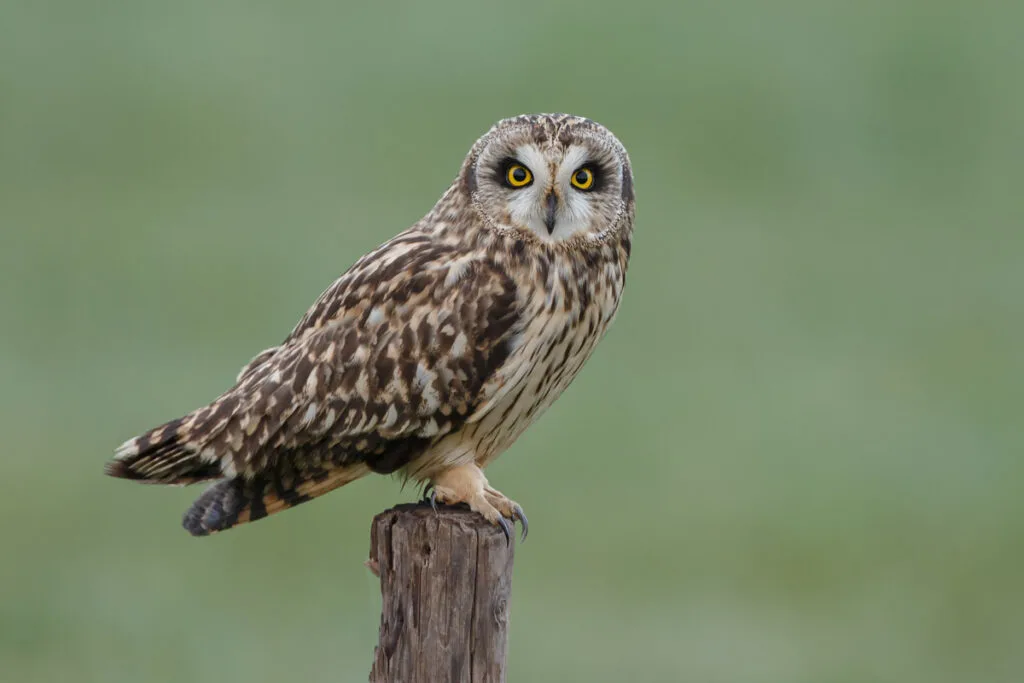
Short-eared owls sometimes move south to strip mines that’ve been reclaimed and rehabilitated.
Often immigrating from their native grassland and open area breeding range, short-eared owls are jet setters. Sailors report seeing them rest on ships hundreds of miles from land.
These owls (Asio flammeus) could also be considered a 33.5-40.5-inch wingspan helicopter parent of the Strigiformes order.
Females would instead relieve themselves in their nests than leave their eggs to go to the bathroom elsewhere.
This eyebrow-raising parental anxiety is said to help deter bald eagles and many of its other diurnal raptor enemies.
Because the owl’s small mammal diet of primarily voles and mice does a number on these would-be predators’ nostrils.
The owls are medium-sized at 13.4 to 16.9 inches tall and weigh 0.456 to 1.05 pounds.
When searching for them, check for a yellow-eyed pale face working spotted medium brown plumage with a white and buff upper body.
4. Northern Saw-Whet Owl
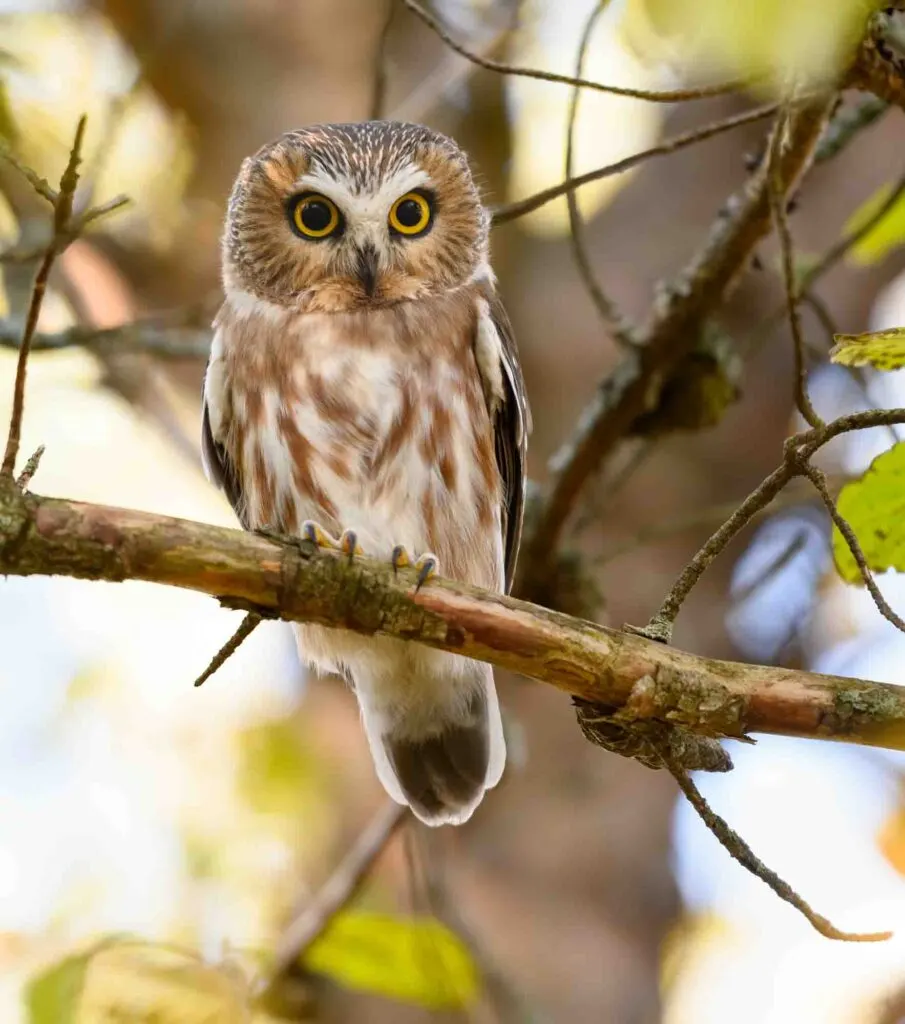
The often-silent Northern saw-whet owl (Aegolius acadicus) takes up a single-pitched tooting sound toward the end of winter and into spring.
The males whistle their tooting to signal dominance over their regular coniferous forest homes.
The owl’s incessant calls can be heard over a half a mile radius, which might vary when they winter in dense-forested southern and central American regions.
Neighboring males reply with a soft toot of acknowledgment. Females reply with an easy speaking swooned swee-call during mating season.
Northern saw-whet owls can also survive in drier grassland areas as long as they have their low-hanging perching spots, which they can use to swoop down on unsuspecting mice during the owl’s night hunts.
With its 7-8.5-inch and 0.166-0.22-pound gnomish stature, the brown-speckled Northern saw-whet owl’s especially adept at hiding.
Even with its fame as one of North America’s smallest owls and aid from its whitish rounded head and white and brown dome, birders will have a difficult time spotting it.
5. Eastern Screech-Owl
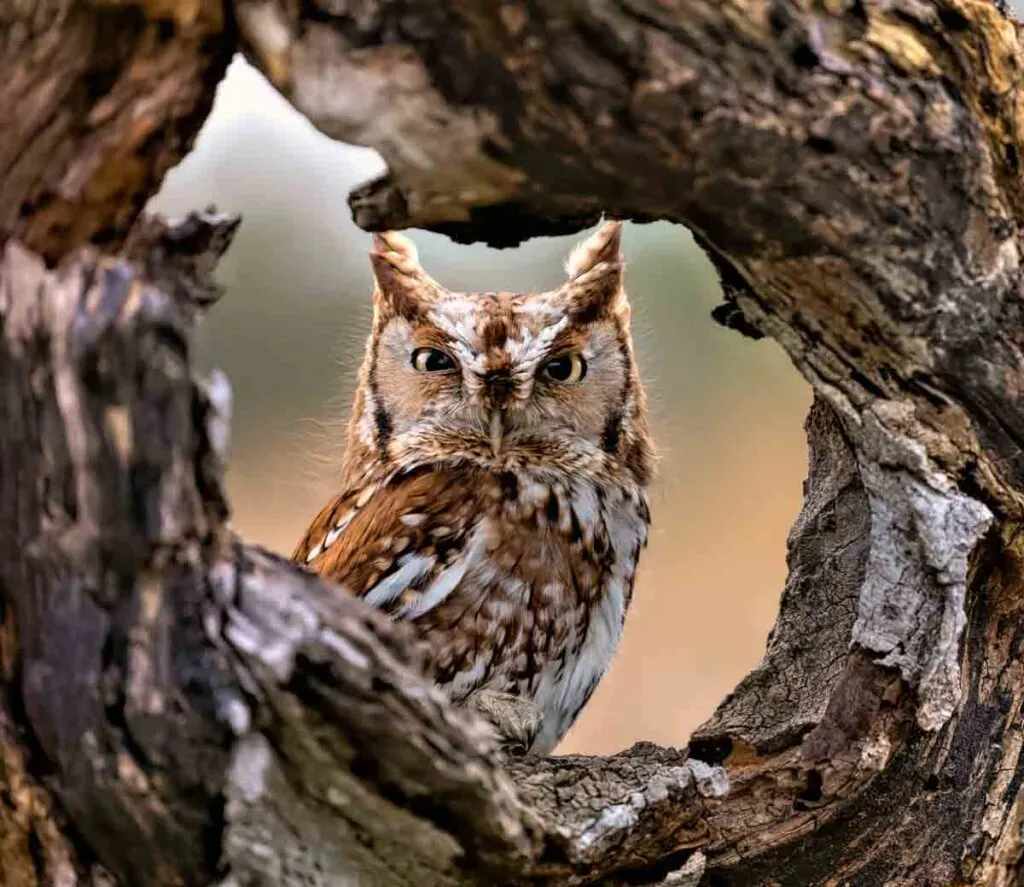
Although these owls inhabit deciduous woodlands and shade trees, you might find them mucking about in residential areas.
You know, like at the beginning of any suburban film worth its salt. These raptors aren’t too bothered if they can’t find large, dead trees to nest in these areas as they’ve adapted to using nesting boxes.
As Eastern screech owls are relatively common throughout Mexico to Canada, you might be able to observe their peculiar relationship with European starlings.
That’s because European starlings are included in the Megascops asio‘s varied palette.
The owl has a taste for small birds and mammals, rodents, reptiles, rabbits, and even their kind that’s smaller than the owl’s standard 0.352-pound body.
If cannibalism wasn’t strange enough, the owl could sometimes get evicted from its nest, its European starling prey.
Like our previous owls, Eastern screech owls are primarily active at night when they do most of their hunting from a perched position for ground prey.
6. Western Screech-Owl
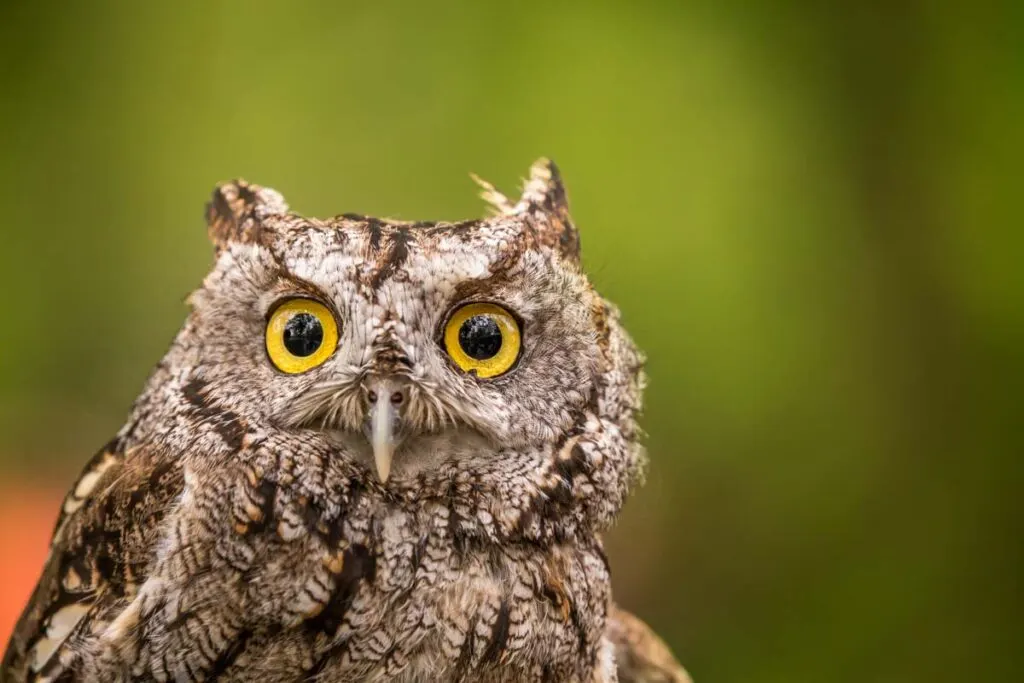
The western screech owl isn’t an enormous true owl at seven and a half inches long, but its 0.352 to 0.397 pounds of adorability weighs closer to a more medium-sized owl.
Otus kennicotii macfarlanei prefer more diverse regions of water and land presence, riparian areas.
These owls also like many types of urban to rural forests where they enjoy dining on giant insects and the usual unfortunate lot of small mammals.
These birds used to have a broader geographical footing, being common across the nation except in Columbia Basin.
They are now primarily found in Central and North America, and their population isn’t doing so hot, thought to be in the tens of thousands.
Their population decline is suspected to be influenced by their moderate sensitivity to our shared climate change turmoil.
Their presence and propagation in western Washington seem to have clashed with barred owls, an irresistible force, and the screech-owl of the west wept.
7. Australian Boobook
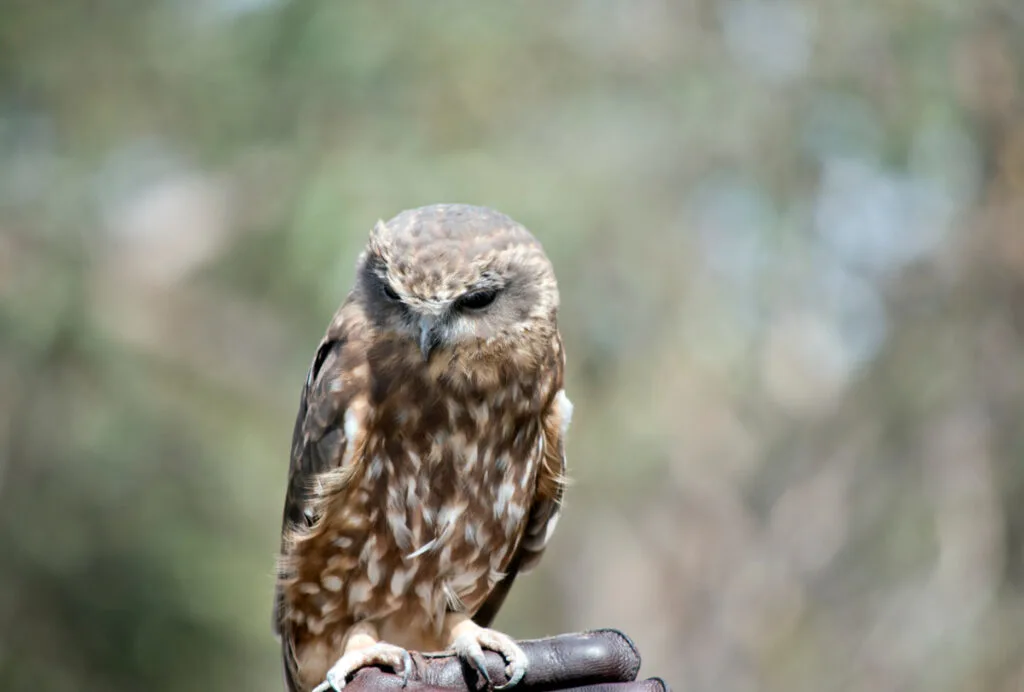
The 0.32 to 0.74-pound Australian boobook has a fun name worthy of hailing downunder.
The boobook is commonly found across the eucalyptus forested plains of Australia, New Zealand, Timor and New Guinea, and the lesser Sunda Islands.
When the boobook isn’t making deep and rapid grating-old-millstone sounds or playing mind games with odd moments of yeowing, it’s earning its name with its double “boo-book” sounds.
It’s not only its pitch that’s stylish about the boobook’s behavior as it’s known to put on an acrobatic show when catching its prey.
These unwitting participants and spectators of the show are usually arachnids and other invertebrate insects and prey like moths and crickets.
They also enjoy some boo-booky helping of vertebrates, with birds and bats being part of the dietary mix.
Ninox novaeseelandiae or Ninox boobook is described as having a stable population that bodes well for variation as they are the smallest owl in the owl species in Australia.
8. Barn Owl
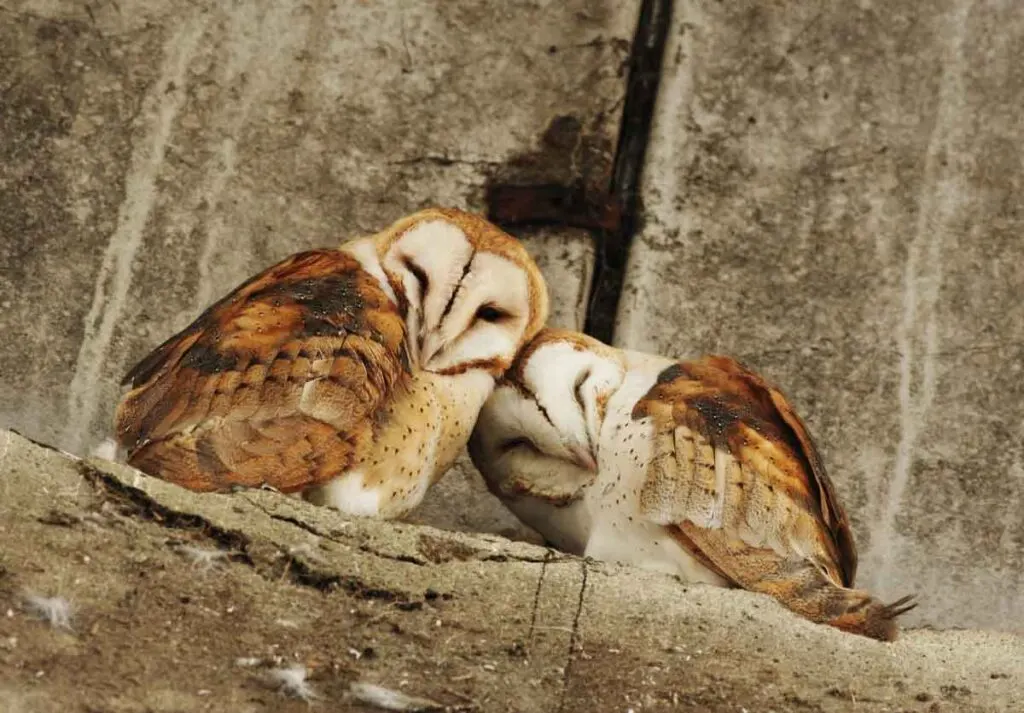
The barn owl (Tyto alba) gets its name from its habitat preference. During the day, you’ll see this owl resting in caves, dense trees, and hollow caves.
You might see it with a partner since it is one of the animals that mate for life, but it’s also comfortable and keeps itself company.
Generally, these owls have heart-shaped faces and prefer open, often dry, areas, which are why farmer finds them in barns, earning their keep.
Proving their worth includes bringing their cuteness to barns and being kept by farmers to help naturally control pests that regularly plight these people of the land.
The pest-controlling characteristic of the barn owl benefits all parties involved, saving the pests.
That’s because the diet for barn owls would include these small mammals, rodents, and rabbits.
As pests aren’t ideal for a farmer’s profit, desperate farmers resort to chemical pest control which is enough to poison even these 0.948-1.367-pound owls.
The availability of food and habitat are about the only things constraining the barn owl’s widespread distribution in Australia.
9. Barred Owl
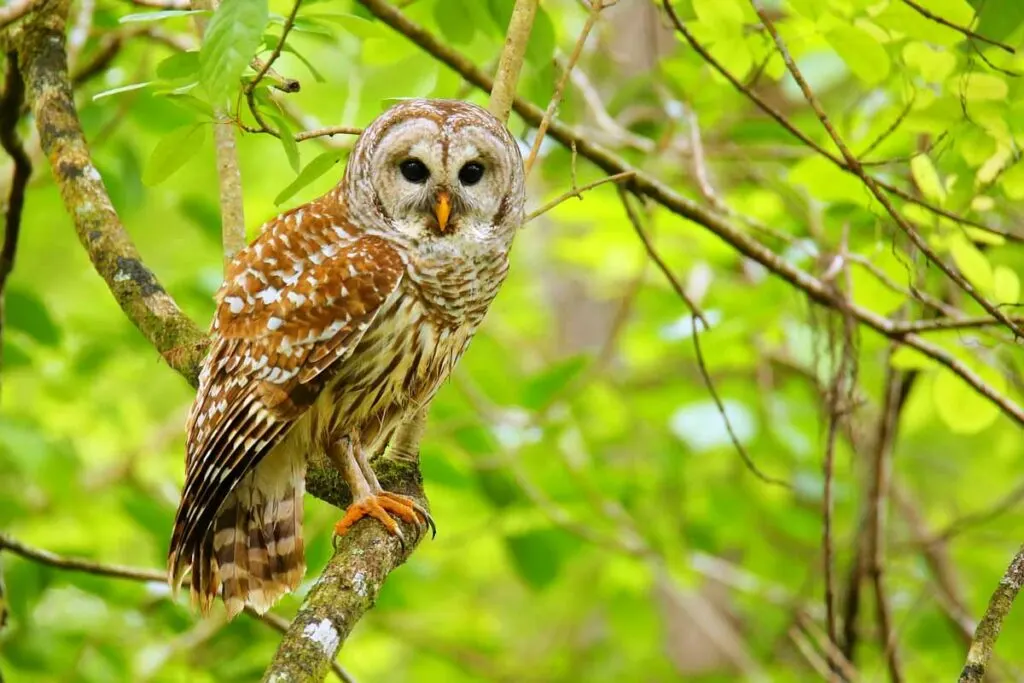
Barred owls (Strix varia) of the Strigiformes order, or more warmly, the barred owl of the true owl order, currently has a stable population that we should be able to bird watch for some time.
Barred owls sometimes go by hoot owls, primarily because of their distinctive hoo-hoo calls, but it would be a lovely addition to their lore if their nickname were also due to the featherless tufts and striped owl’s gullibility.
The barred owl will humorously reply and sometimes approach people who imitate their call, which we’ve just learned isn’t all that difficult.
A barred owl’s diet is usually large-sized insects and small mammals, weasels, rodents, and such.
Barred owls are opportunistic feeders and eat a wider diversity of food than other owls, including some reptilian and fish meat.
These 1,58-ish-pound birds usually roam the forests of Southeast Alaska and deep woods over the southeastern, western, and northern US and Pacific Northwest.
10. Boreal Owl
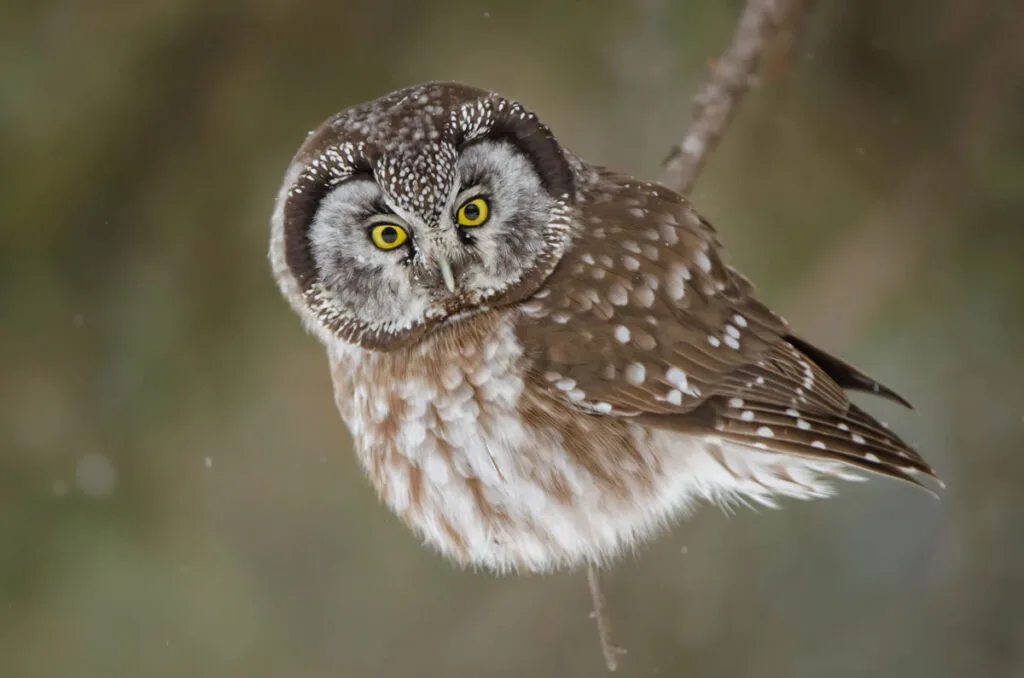
Boreal owls (Aegolius funereus) have a similar appearance to saw-whet owls but have a larger build. Boreal owls are 0.265 pounds, and their wingspan of 20 to 24 inches tells of how small this 8.7- to 10.6-inch-tall raptor is.
Around its Alaskan and Canadian distribution, the owl’s name is of mythical origins from the Greek god of the north wind, Boreas.
On the other side of the world, in northern Europe and the Soviet Union, the owl has a humbler and learned background by being named after a Swedish naturalist, Tengmalm’s owl.
The owl migrates to different mixed hardwood and northern coniferous forests, letting the winds take them to where rodent populations call them.
Boreal owls primarily feed on small nocturnal rodents and voles.
11. Burrowing Owl
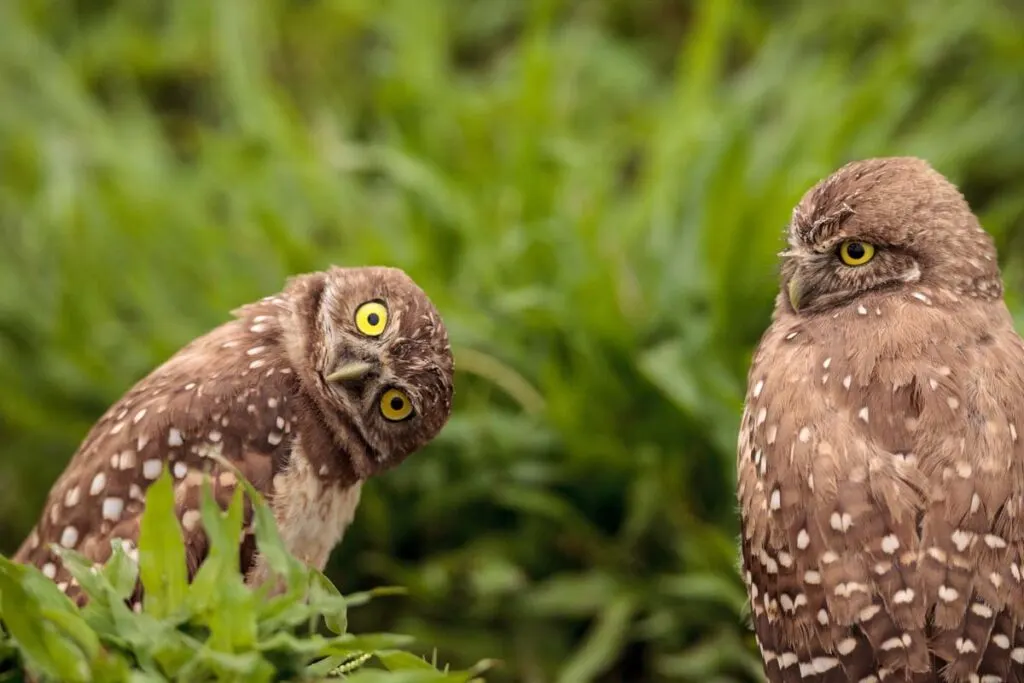
Burrowing owls are some of the most interesting in the Strigiformes order and Aves class.
One of the main things you’ll hear about these endearing owls is their liking for squatting and nesting burrows made by ground animals.
Burrowing owls are also famous for being genuine with people by having their feet on the ground by running when hunting reptiles, giant insects, and rodents.
They also have an allowing diet as they feed on fish and small birds, with a few reports of those birds being of kin.
Burrowing owls (Athene cunicularia) are native to the deserts in the US, more specifically in the western region.
They find their winter homes in the southwestern parts of the country, with winters more tolerable for the owl. You’ll also spot them in drier parts of South and Central America.
At a meager height of 9 inches and 0.25-0.438 pounds, burrowing owls must rely on other methods to fend off predators.
This is why burrowing owlets will make a cry that sounds like a rattlesnake to scare predators and probably befuddle other rattlesnakes.
12. Elf Owl
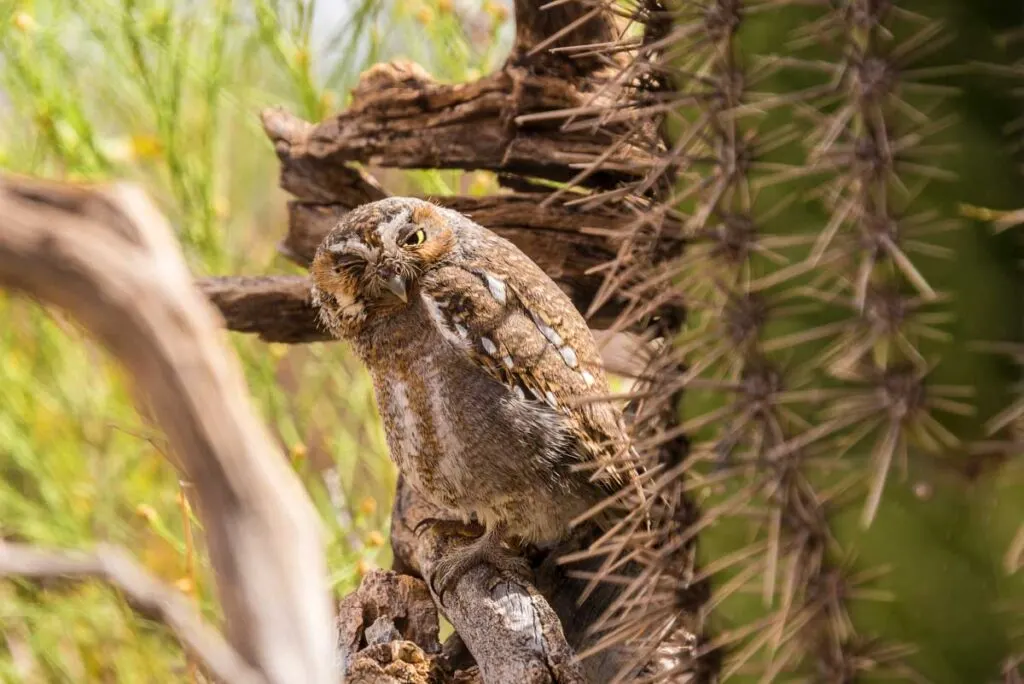
As implied by its name, the elf owl is North America’s smallest owl.
The elf owl (Micrathene whitneyi) can grow to a length of about 5.5 inches, over 3 inches smaller than the Northern saw-whet owl. Fully grown adults weigh only 0.090 pounds!
The previous sentence was loud because some paperweights weigh more than double the elf owl.
Regardless of their size, elf owls are also nocturnal predators that eat mostly scorpions, grasshoppers, and other insects.
If scorpions weren’t daring enough, elf owls would also hunt mice and small lizards, just the descendants of the original “terrible lizards”–dinosaurs.
Elf owls are Texans, found around the dry Big Bend and some regions of the Chihuahuan desert.
These owls will nest and raise their youngins in West and southwest Texas. While their family life is in Texas, elf owls will winter in central Mexico.
Adorably, elf owls will often make a home in holes made by other animals in giant saguaro cacti. You might also see them using telephone poles for nesting.
13. Flammulated Owl
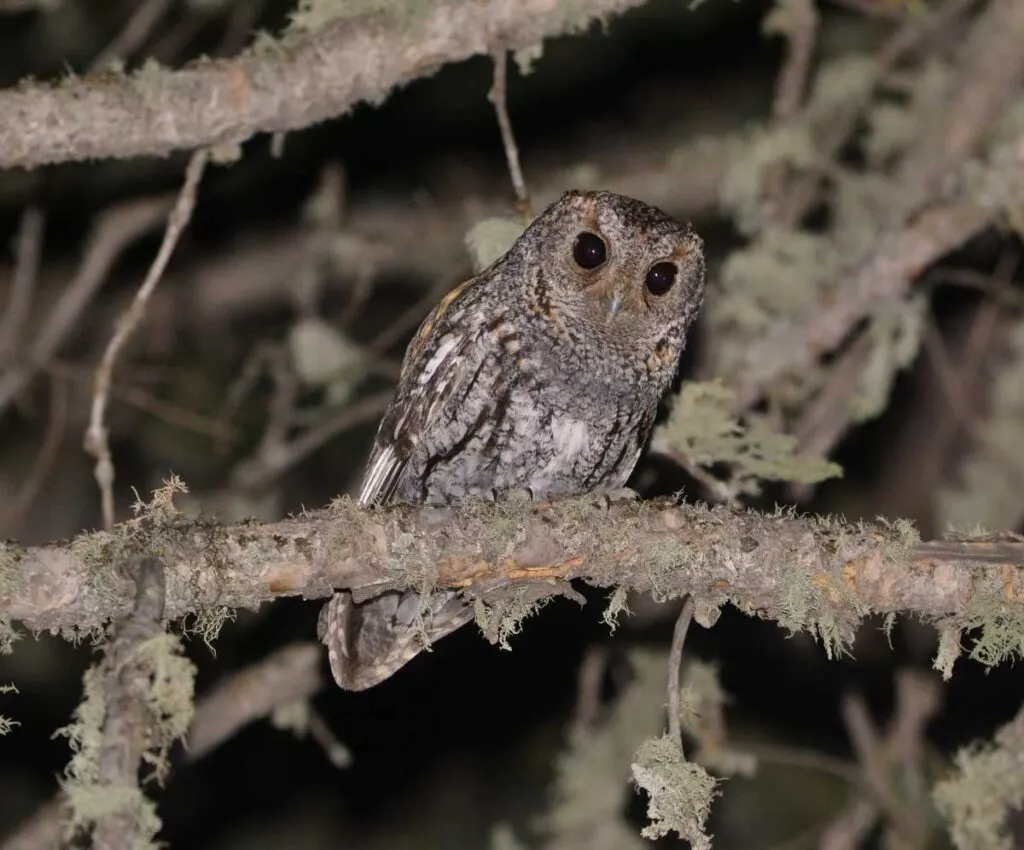
With a 14-inch wingspan, you know there isn’t much to weigh down the flammulated owl.
The primarily nocturnal flammulated owl (Psiloscops flammeolus) male weighs only 0.110 to 0.115 pounds, while the female weighs somewhat more at 0.137 to 0.143 pounds.
Flammulated owls primarily winter in the south of the US but can sometimes be found in South Texas, California, and Arizona.
During the breeding season, flammulated owls like to set nests in British Columbia and the western US to central Mexico.
Like other owls, these will sometimes indulge in small mammal delicacies such as shrews and similarly-sized rodents.
However, these owls prefer their diets being mostly made up of insects. Butterflies and moths are usually the main dishes, with date nights seeing beetles and crickets being introduced into the mix.
14. Great Gray Owl
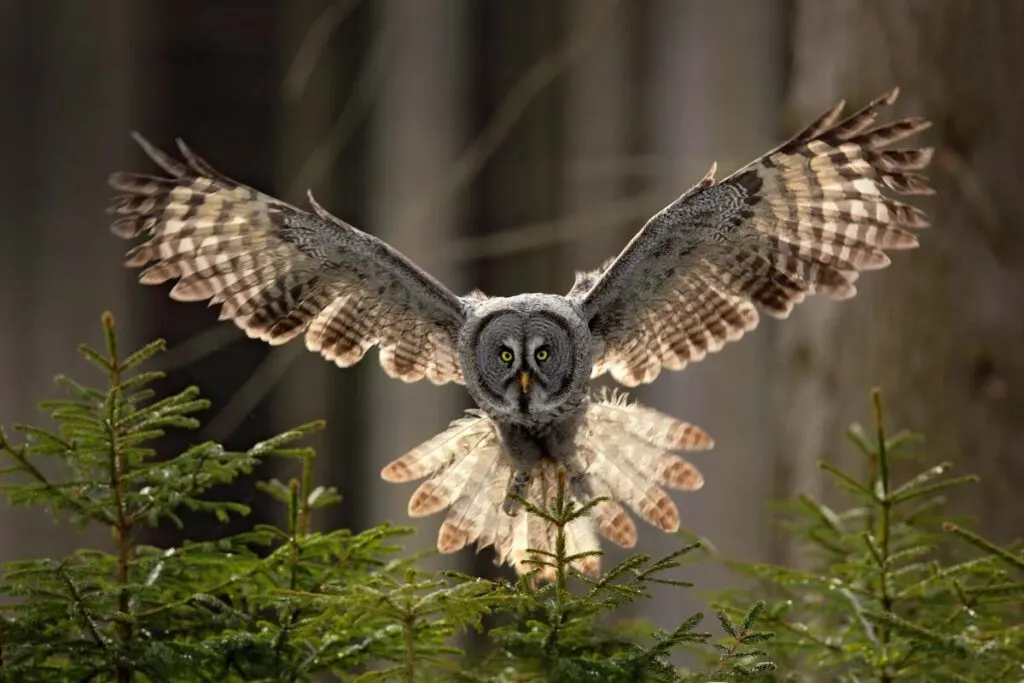
Give the great gray owl some gray-brown conifer bark to rest its sharp talons on, and anyone else who didn’t see your generosity won’t know it’s there.
Great gray owls blend so perfectly into such environments that they have been called the Phantom of the North and the Great Gray Ghost.
At a whopping 2.43 pounds, the great gray owl (Strix nebulosa) seems to command the dense northern boreal forests they usually inhabit.
North America and Eurasia are the bulk of the land they occupy, but they have been known to dip south to as far as the Pacific Northwest and those breathtaking Rocky Mountain sunsets.
They might go even further south to have better luck with food in the winter months.
Surprisingly, the great gray owl doesn’t resort to being a greedy feeder to sustain its figure. These owls mostly eat small rodents, with 90% of their diets being voles.
15. Northern Pygmy Owl
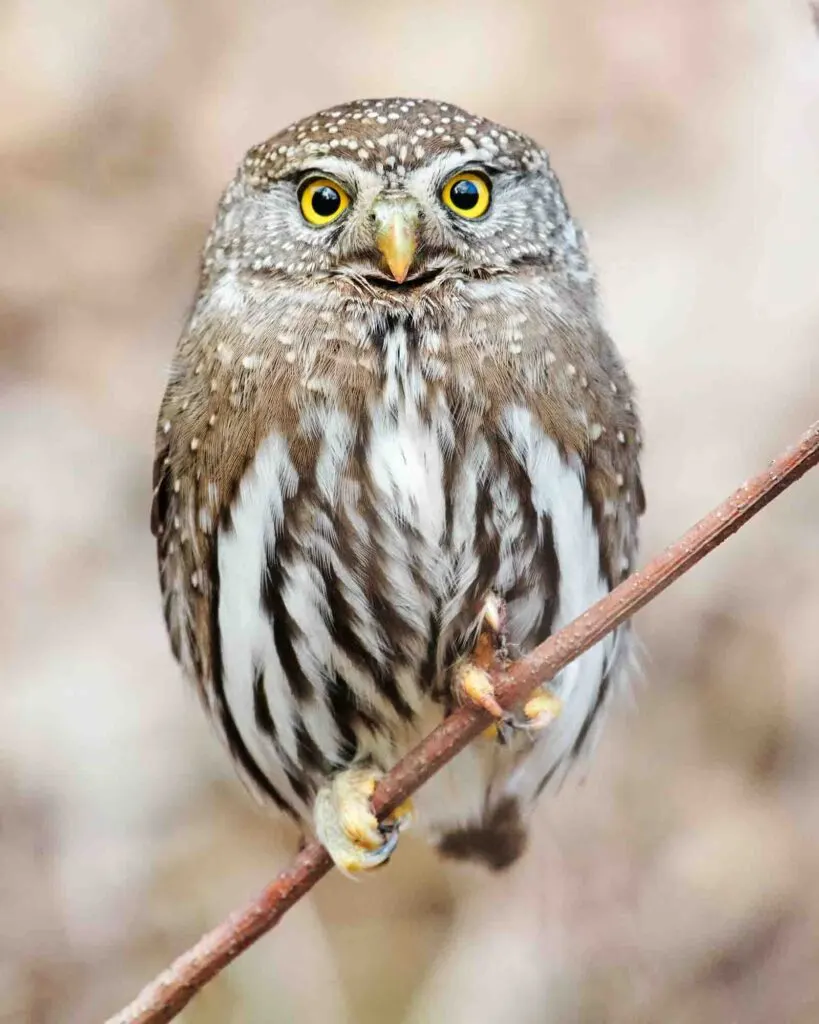
Northern pygmy owls are cute animals found in many partly open forest habitats. They are recognizable from their lack of a pronounced facial disk.
For people that love sharing, the Northern pygmy-owl (Glaucidium gnoma) is spread throughout the US, Canada, Mexico, Honduras, and Guatemala.
Besides not having a facial disk to set themselves apart from their kind, like a kid that went to private school, these 0.134-pound owls hunt more during the day, which makes them primarily diurnal.
With a location- and season-dependent diet, these owls still eat like other owls: lizards, birds, rodents, and insects.
16. Long-Eared Owl
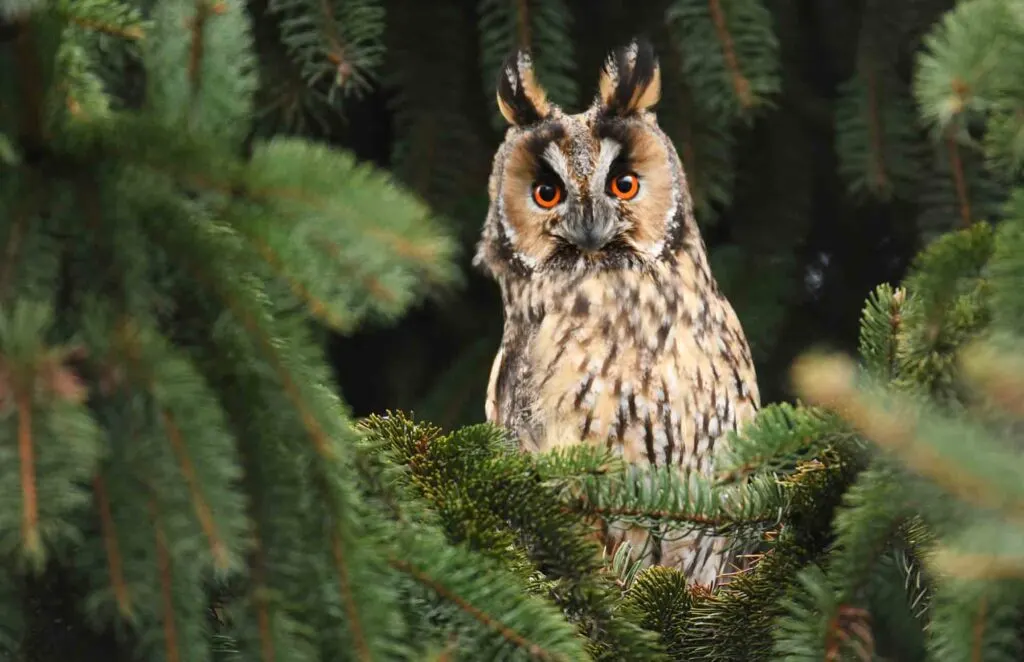
Long-eared owls are basically saints, as their varied diet of small mammals, voles, rats, shrews, and young rabbits, helps keep a tight leash on pest populations.
On top of the long list of small mammals, rodents, and all, they also eat some small birds, insects, and snakes.
They also provide residence to many internal and external parasites, something of an example for us as we regularly grapple with housing issues.
The 0.485 to 0.959-pound long-eared owl (Asio otus) is like making a home near open areas in lands with forests and shrubs.
Long-eared owls are typical across many parts of the northern hemisphere and extend their environments by living on agricultural and riparian lands.
17. Northern Hawk Owl
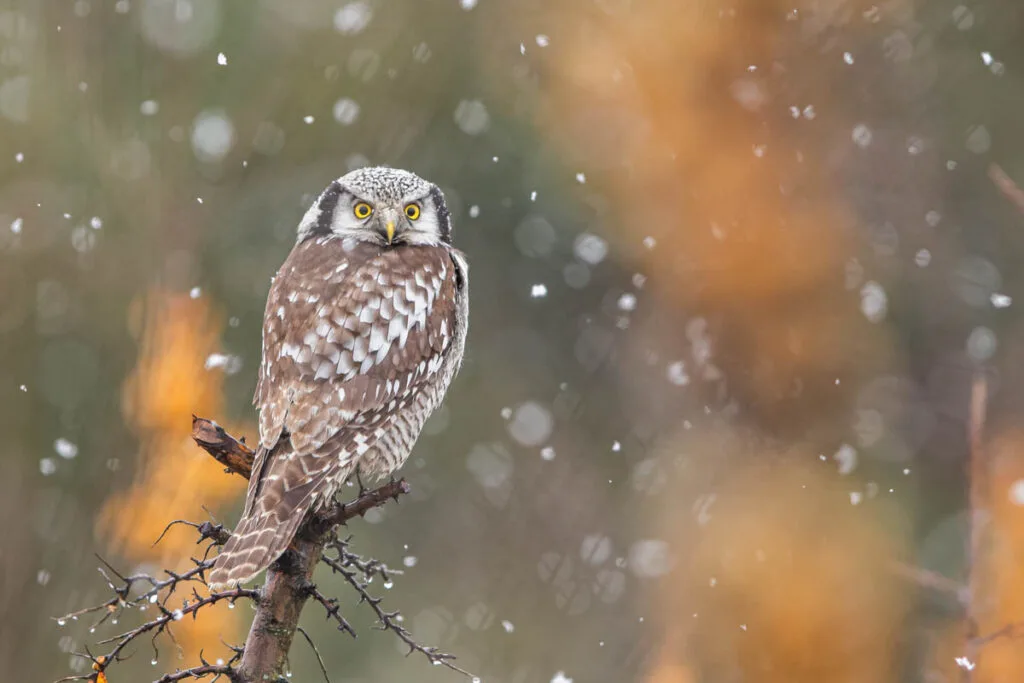
Northern hawk owls can startle new birders with their Joker-like ki-ki-ki nervous laughter. Their screeching and whistling also don’t do the 0.661-pound bird any favors.
But despite their ominous countenance, Northern hawk owls (Surnia ulula) are dolls as they remain calm when curious humans with sticky hands approach them.
This owl is considered fatter than most owls which makes sense as their winter diet in their northern forest and bog neighborhoods involves other birds.
Their summer menu is less of a Hannibal Lecter flavor as they favor rodents.
18. Snowy Owl
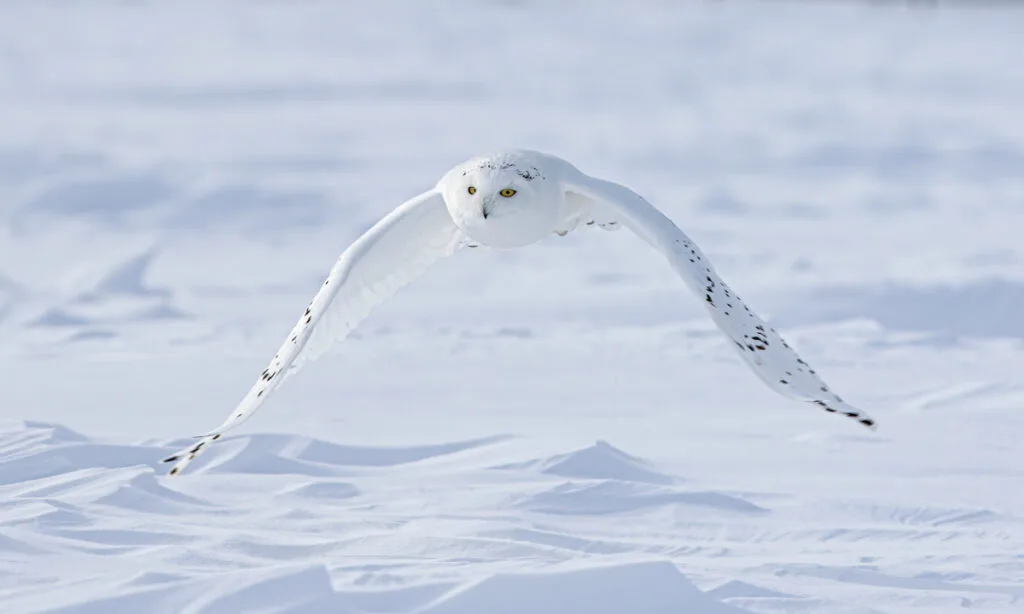
Besides their blindingly gorgeous white coat, snowy owls are famous for many things. Laying around twelve eggs at a time, snowy owls are among the most fertile.
Above everything else, snowy owls are also celebrities; as you might know, appearing as Hedwig in some little-known series of films called Harry Porter.
This snowy owl (Nyctea scandiaca) might not deliver wizarding news to blow your heritage out of the water.
Still, these elusive 3.53-6.61-pound birds will be a blessing for your eye sockets. As to go with their name, these often solitary and carnivorous birds go by blizzard or drift when spotted as a group.
Snowy owls are sometimes found in Missouri over winter, but that’s a rare occurrence as they stay in Eurasia and the arctic regions of North America throughout the year.
So, what do these long-living celebrities eat? Virgin blood of small mammals! As if these Keanu Reeves only eat small mammals that willingly offer their flesh, like lemmings, ground squirrels, rabbits, and such.
Snowy owls are opportunistic hunters who prey on birds and fish and scavenge for carrion.
19. Spectacled Owl
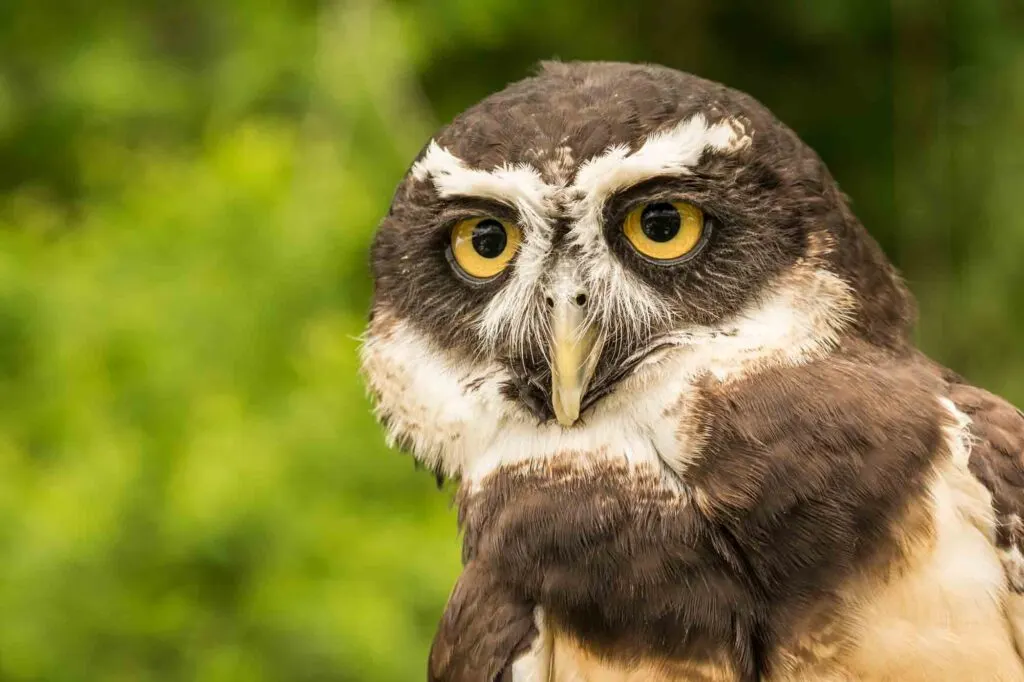
It’s written in their genes and name; spectacled owls are scholarly-looking little birds.
You search out and study spectacled owls (Pulsatrix perspicillata) in their office on the grounds stretching from Southern Mexico to Argentina.
Spectacled owls also make an appearance in Trinidad and other select Caribbean islands.
Like the different types of owls we’ve covered, females often grow larger than males. Females weigh 1.5-2 pounds while males grow to 1-1.5 pounds.
To fuel themselves, spectacled owls will have only top-shelf insects and mice.
They are also known to have a taste for crabs, bats, frogs, possums, skunks, and birds smaller than them. These birds are surprisingly fast when catching their prey.
More Types of Owls
Whiskered Screech-Owl
Baja Pygmy-Owl
Southern White-Faced Owl
Eurasian Pygmy-Owl
Indian Scops Owl – an interestingly weird bird
Jungle Owlet
Striped Owl
Mottled Owl
Eurasian Eagle-Owl – one of the largest birds of prey
Buffy Fish Owl
Interesting Facts About Owls
Even as advancement in science has helped demystify these birds, some facets of owls are still being uncovered.
That’s why there are still so many interesting facts that we’re regularly learning about these birds. A few of those facts are briefly explored in the following bullet points.
- Female owls are often bigger than males. While the reason is still not fully understood, it’s thought that males evolved smaller because of the abundance of smaller prey, and females needed more bodies because of reproduction duties.
- Something of a symbiotic relationship has developed between farmers and owls. Owls act as a natural pest control for farmers. Farmers save money and time by not accidentally poisoning the owl’s food source through chemical intervention.
- The long-eared owl appears in the famous Chauvet Caves and is estimated to have been drawn 30,000 years ago.
- Although owls don’t have any particular animosity toward us, they appear indifferent to our existence and don’t foster any loyalty, and can’t be trained. As if out of curiosity or bipedal comradery, some owls will allow people to approach them.
- It’s illegal to keep an owl as a pet in the United States, regardless of the types of owls you have an eye on. But it is legal to own one in Japan as they are considered symbols of wisdom and fortune.
- All types of owls don’t go blind in a flood of light any more than any creature would momentarily stumble. Despite the size of their eyes, the owl’s pupils function independently of each other and reduce their size to protect the sensitive retina in daylight.
Did you enjoy learning more about the different types of owls? Share this fun article on your social media!
19 Magnificent Types of Owls to Spot in the Wild
1. Great Horned Owl
2. Ferruginous Pygmy-Owl
3. Short-Eared Owl
4. Northern Saw-Whet Owl
5. Eastern Screech-Owl
6. Western Screech-Owl
7. Australian Boobook
8. Barn Owl
9. Barred Owl
10. Boreal Owl
11. Burrowing Owl
12. Elf Owl
13. Flammulated Owl
14. Great Gray Owl
15. Northern Pygmy Owl
16. Long-Eared Owl
17. Northern Hawk Owl
18. Snowy Owl
19. Spectacled Owl
